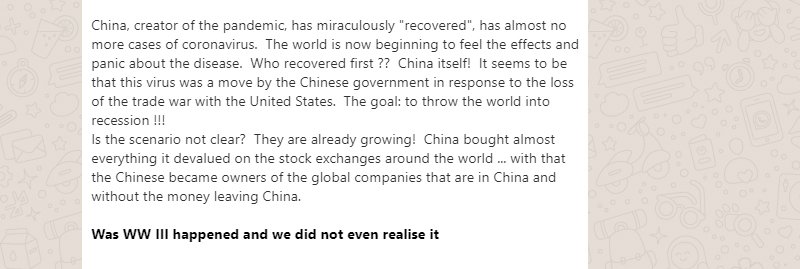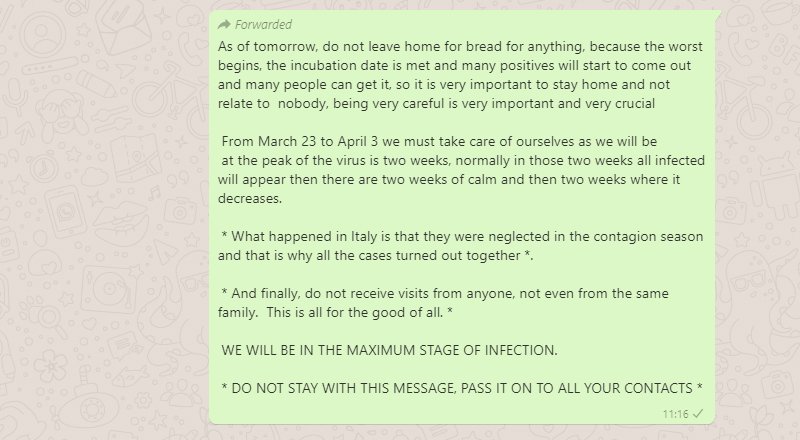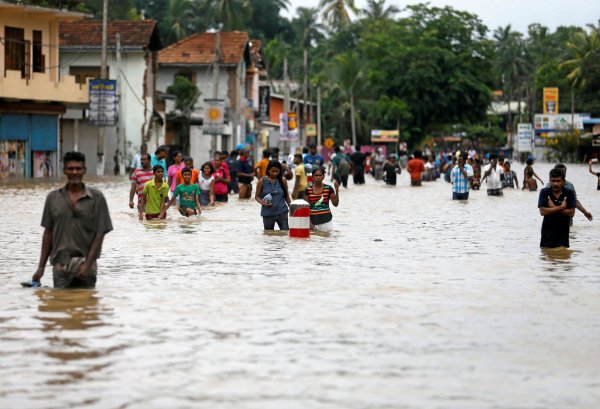
Online messaging platforms like WhatsApp, Viber, Signal, and Telegram have become pivotal sources of information in the digital age. While these platforms facilitate positive communication and create a sense of community, it is also a breeding ground for misinformation and disinformation that can cause confusion, at best, and physical harm or death, at worst.
This is particularly evident during national or global crises when there is a desperate need for information. At times like these, information is sometimes created and disseminated with the deliberate intention of misleading. These soon take on a life of its own as it spreads rapidly through communication networks.
Not all of it is with malicious intent however; some are simply created or shared with the best of intentions but have the potential to cause serious harm. We have seen this before, in Sri Lanka, and we’re seeing it again, globally, during the current COVID-19 pandemic.
Take a look at some of the WhatsApp forwards we’ve included below–you may have seen, received or even shared these with your own peers.
Forward #1 — Tea Is A Cure

COVID-19 currently has no cure. While many nations and companies are working on a treatment and a vaccine, the trials are yet to succeed.
The compounds mentioned in the message are very real and Dr Li Wenliang did attempt to call to attention the initial spread of the coronavirus and later died from it.
However, there is no verifiable information to prove that doctors in China are serving tea to COVID-19 patients, or more importantly—that tea is a cure for or will help reduce possible infection.
Just leave tea-drinking for your customary evening break.
Pro tip — Note the mix between fact and fiction: this makes it difficult for people to use a common-sense approach. Most resort to ‘forwarding as received’—an attempt at absolving responsibility for the veracity of the content, but that’s not enough. Take the time to research the information before you share it. Note the ‘Breaking News from CNN’ tag—get onto the CNN site, type in the keywords, and see for yourself if it is true.
Don’t believe us? Check AFP Fact-Check here.
Forward #2 — The Disease Is Airborne

While the link to the CNBC article is accurate, the content in the message is not.
The link explains that the World Health Organisation (WHO) is considering ‘airborne precautions’ for medical staff after a new study showed the coronavirus can survive longer than usual in the air in some settings.
The setting referred to were at medical care facilities where aerosol-generating procedures (procedures that stimulate coughing) are conducted on people with respiratory illnesses. In these settings, it would be necessary for healthcare workers to take extra precautions.
At no point in the article is there any indication that COVID-19 can remain in the air for eight hours. At no point has the WHO said everyone is required to wear masks everywhere—in fact, the WHO is very clear on who and how masks should be worn and has also advised the rational use of medical masks to avoid unnecessary wastage of the resource.
What has been established is that COVID-19 spreads from person to person when an active COVID-19 patient coughs or exhales and produces droplets that come into contact with another person.
Since the droplets are too heavy to be airborne, they land on people in close proximity or objects and surfaces that are then contaminated. Other people can become infected by touching these contaminated areas and then touching their eyes, nose or mouth.
This is why maintaining at least a metre distance from other people, and washing hands regularly for at least 20 seconds with soap and water or an alcohol-based sanitizer is encouraged.
Pro tip: Click on the link and read it carefully before sharing. Does it corroborate with what is being said in the ‘forward’? If it doesn’t, discard. If it does to some extent, you still may want to do some additional research and reading before sharing unverified information.
Don’t believe us? Read what WHO has to say about it here.
Forward #3 — How To Avoid The Virus

You do not have to wash your hands every 20 minutes. Instead, wash your hands with soap for at least 20 seconds, especially if you have; stepped out of the house, just coughed or sneezed, or have come into contact with another person—and most definitely if that person is already sick.
Secondly, hot water does not kill the virus, gargling with warm salt water or vinegar does not prevent infection, and clothes must be washed and dried—it is not a choice of one or the other.
Since most of these tips appeal to common sense it may be easy to assume all of it is factual and to share with as many people as possible—all with the intention of being helpful. But the wrong information can have dangerous unintended consequences.
There are documented cases of severe illnesses or even death as a result of drinking bleach, methanol, or eating copious amounts of garlic to prevent COVID-19. People may also believe these simple methods are enough to prevent them from contracting the virus and not take enough precautions.
Fact-check tip: Take time to study these claims. It may require more work than simply sharing it, but you would be doing your part at being a responsible citizen—remember you can help break the misinformation/disinformation chain.
Don’t believe us? All of this has been very effectively addressed in the WHO ‘Mythbusters’ section here.
Forward #4 — A Bioweapon

This forward claims that the virus that killed over 3,000 people in China was engineered as a bioweapon and released to destabilise and allow China establish a firm foothold in the world.
The claim is seen as part of a disinformation campaign against China or as a conspiracy theory that has been debunked by many accepted publications.
If you’re still not convinced, here’s what Tom Inglesby, Director of the John Hopkins Center for Health Security had to say “… there isn’t any evidence that this virus has been engineered or is different from something that has been found in nature.”
Fact-check tip: Notice the claim that China had become the owner of global companies in China as a result of economic destabilisation? Do a little research and see if that is true.
Want further proof? Read what WHO has to say about the natural—and not constructed—origin of the virus, here.
Forward #5 — Miracle Medicine

Hydroxychloroquine sulfate is currently used for the prevention and treatment of malaria. Reports of the drug’s efficacy in the battle against COVID-19 began in South Korea, which recommended the drug after an experimental treatment.
Later in the United States, President Donald Trump claimed it showed “tremendous promise” in treating COVID-19 patients, despite the director of the country’s National Institute of Allergy and Infectious Diseases, Dr Anthony Fauci saying the drug is yet to be considered for trials.
The drug made headlines in Sri Lanka as well, when Opposition Leader Sajith Premadasa recommended its usage. He later retracted his statement and issued an apology after a public outcry. Health authorities here also strictly instructed people not to buy or use the drug without medical advice and pharmacies were prohibited from selling the drug without a prescription.
Pro tip: It’s easy to get excited about a rumoured treatment for COVID-19—it’s even understandable that you may want to stock up on the drug, so that you are not left without when you need it. But as a rule of thumb, you should never take any medicine that isn’t prescribed by a doctor, especially in evolving public health situations like these, when no clear medical solution has been discovered.
Want to know for sure? See what WHO has to say about it.
Forward #6 — Steam, Salt and Vinegar

Steam inhalation is a common and effective way to clear your nasal passages if you’re sick with a cold or flu—but COVID-19 is not a common cold and steaming will not help a patient recover in ‘double-quick time’.
This sort of common-sense advice has appeal because it is uncomplicated and people feel it would do them no harm to steam, anyway. However, the damage is that it trivialises the potentially deadly nature of COVID-19.
Steaming will not prevent you from contracting COVID-19, either. At this stage, we know that social distancing and hand hygiene are probably the best way to do this. By sharing this sort of information you are endorsing an ill-informed view that could potentially cause harm to someone.
There is also no evidence that the doctors at the National Infectious Diseases Hospital (IDH) are inhaling steam.
Fact-check tip: Read and understand the severity of COVID-19. Does it seem possible that a virus that has spread so fast all over the world and claimed so many lives can be prevented by something so simple as steam inhalation—and if yes, why is it not being propagated as a solution more by health authorities? Nothing short of a conspiracy theory can prevent you from coming to the logical conclusion that a steam inhalation can’t be the solution to the virus. Why not use that as a stepping stone to find out what the experts are actually saying?
Don’t believe us? See what AFP FactCheck has to say about it.
WhatsApp Forward #7 — Incubation Period

As per the WHO, an ‘incubation period’ is the time between contracting the virus and showing first observable symptoms. An incubation period will vary from person to person—most estimates of this incubation period range from 1-14 days, with an average of five days.
This is why the government moved swiftly to put people who arrived in Sri Lanka into two weeks quarantine from early March onwards, where they are kept under observation for any developing symptoms.
Similarly, the government moved fast to round up those that may have come into contact with confirmed cases (contact tracing) and impose a 14-day quarantine period on them as well, during which they are watched over for symptoms.
While it is likely that a number of people will display symptoms at the same time—if they have come into contact with an active case within a similar time frame—it is not possible for everyone who has contracted the virus to develop symptoms at the same time.
For these reasons, it is clear that there was absolutely no truth to the claim that 23 March – 3 April is when the virus will ‘peak’. However, ‘forwards’ like this have the real ability to cause panic and fear and even instigate panic buying increasing the chances of people coming together and the risk of the virus spreading.
It can also lead to the mistaken belief that after ‘3 April’ the worst will be over.
Fact-check tip: It is safe to take these ‘forwards’ with a pinch of salt. Rest assured, if there was something to be worried about, the relevant authorities would have introduced measures and published informed statements. Follow authentic sources, instead of your WhatsApp forwards.
Want to know more? Click here.
HOW TO ENSURE YOUR SOURCE IS TRUE:
These WhatsApp forwards are only a small sample of the fake news out there. Some are far more serious than others, and even purport to be from established and authenticated sources—so remember that even if you receive some information that professes to be from WHO, the United Nations (UN), the Sri Lankan government, or an established news website—it might not be necessarily true.
It only takes a few clicks to find out if the ‘forward’ you received is credible information. Go to the actual website. Does the WHO/UN/Sri Lanka government/News website say the same thing?
It is also good practice to have more than one established source corroborating the information — so even if one news source is propagating a certain bit of information, it is good to wait till several others say the same thing to establish that there is some truth to the claims.
Stick to established sources. It is not a good practice to get your news and information from gossip sites or less than reputable news sites. Always make sure you visit established websites for information.
In a world where citizens now have the power to create, hold, and distribute information—the public has an even larger role to play as consumers of the media.
If you cannot verify a piece of information with a reliable source, do not share it. You, more than anyone else, can break the fake news chain.








